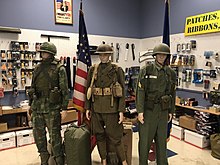
Shopping is an activity in which a customer browses the available goods or services presented by one or more retailers with the potential intent to purchase a suitable selection of them. A typology of shopper types has been developed by scholars which identifies one group of shoppers as recreational shoppers, that is, those who enjoy shopping and view it as a leisure activity.

Inventory or stock refers to the goods and materials that a business holds for the ultimate goal of resale, production or utilisation.

A grocery store (AE), grocery shop (BE) or simply grocery is a foodservice retail store that primarily retails a general range of food products, which may be fresh or packaged. In everyday U.S. usage, however, "grocery store" is a synonym for supermarket, and is not used to refer to other types of stores that sell groceries. In the UK, shops that sell food are distinguished as grocers or grocery shops.

A variety store is a retail store that sells general merchandise, such as apparel, auto parts, dry goods, toys, hardware, furniture, and a selection of groceries. It usually sells them at discounted prices, sometimes at one or several fixed price points, such as one dollar, or historically, five and ten cents. Variety stores, as a category, are different from general merchandise superstores, hypermarkets, warehouse clubs, grocery stores, or department stores.

A charity shop (British English), thrift shop or thrift store or opportunity shop or op-shop is a retail establishment run by a charitable organization to raise money. Charity shops are a type of social enterprise. They sell mainly used goods such as clothing, books, music albums, shoes, DVDs, toys, and furniture donated by members of the public, and are often staffed by volunteers. Because the items for sale were obtained for free, and business costs are low, the items can be sold at competitive prices. After costs are paid, all remaining income from the sales is used in accord with the organization's stated charitable purpose. Costs include purchase and/or depreciation of fixtures, operating costs and the building lease or mortgage.

In British English, a haberdasher is a business or person who sells small articles for sewing, dressmaking and knitting, such as buttons, ribbons, and zippers; in the United States, the term refers instead to a men's clothing store that sells suits, shirts, neckties, and other items.
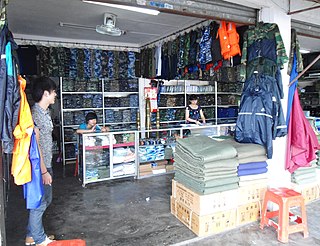
Military surplus are goods, usually matériel, that are sold or otherwise disposed of when held in excess or are no longer needed by the military. Entrepreneurs often buy these goods and resell them at surplus stores. Usually the goods sold by the military are clothing, equipment, and tools of a nature that is generally useful to the civilian population, as well as embroidered patches, name tags, and other items that can be used for a faux military uniform. Occasionally, vehicles will be sold as well. Some military surplus dealers also sell military surplus firearms, spare parts, and ammunition alongside surplus uniforms and equipment.
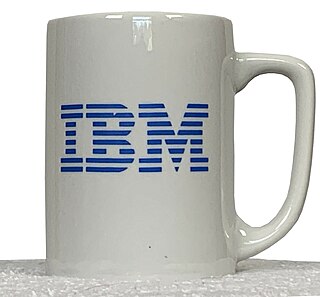
Merchandising is any practice which contributes to the sale of products to a retail consumer. At a retail in-store level, merchandising refers to displaying products that are for sale in a creative way that entices customers to purchase more items or products.
Consignment is a process whereby a person gives permission to another party to take care of their property and retains full ownership of the property until the item is sold to the final buyer. It is generally done during auctions, shipping, goods transfer, or putting something up for sale in a consignment store. The owner of the goods pays the third-party a portion of the sale for facilitating the sale. Consignors maintain the rights to their property until the item is sold or abandoned. Many consignment shops and online consignment platforms have a set time limit at which an item's availability for sale expires. Within the time of contract, reductions of the price are common to promote the sale of the item, but vary by the type of item sold.
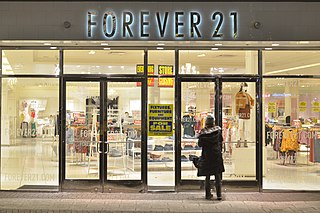
A closeout or clearance sale is a discount sale of inventory either by retail or wholesale. It may be that a product is not selling well, or that the retailer is closing because of relocation, a fire, over-ordering, or especially because of bankruptcy. In the latter case, it is usually known as a going-out-of-business sale or liquidation sale, and is part of the process of liquidation. A hail sale is a closeout at a car dealership after hail damage.
Yellow Front was an American discount store that original started as a single Army surplus store before evolving into a sporting goods chain and later a discount chain.

G.I. Joe's was a privately owned retail chain for sporting goods, ready-to-wear clothing, and auto parts; that operated stores in the Pacific Northwest region of the northwestern United States.
Overstock, excessive stock, or excess inventory arise when there is more than the "right quantity" of goods available for sale, or when "the potential sales value of excess stock, less the expected storage costs, does not match the salvage value". It arises as a result of poor management of stock demand or of material flow in process management. Excessive stock is also associated with loss of revenue owing to additional capital bound with the purchase or simply storage space taken. Excessive stock can result from over delivery from a supplier or from poor ordering and management of stock by a buyer for the stock. Excess or unnecessary inventory is listed as one of the seven wastes or "muda" in Taiichi Ohno's Toyota production system.
The War Assets Administration (WAA) was created to dispose of United States government-owned surplus material and property from World War II. The WAA was established in the Office for Emergency Management, effective March 25, 1946, by Executive Order 9689, January 31, 1946. It was headed by Robert McGowan Littlejohn.

A second-hand shop is a shop which sells used goods.
Stock clearance is an activity by a company where ownership of products and materials moves on to another legal entity. These products and materials in stock clearance will not form the basis of a company's key activities. As such, they are often end-of-line, surplus, returned, or bankrupt.
Wigwam Stores Inc. was an American chain of discount department stores that was based in Seattle and operated across five states: Washington, Hawaii, Oregon, California and Arizona. The discount department store was a fairly new concept when Wigwam's first store opened in 1946. Wigwam Stores' goal was to sell a wide array of products at a lower cost.
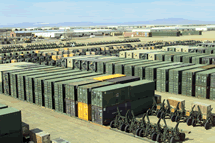
Sierra Army Depot (SIAD) is a United States Army post and military equipment storage facility located near the unincorporated community of Herlong, California. It was built in 1942 as one of several ammunition storage facilities located far enough inland to be safe from Japanese attack, yet close enough to western military posts and ports to facilitate shipment of supplies. The site also met the requirement that the depot be in a dry and isolated area.

A government auction or a public auction is an auction held on behalf of a government in which the property to be auctioned is either property owned by the government or property which is sold under the authority of a court of law or a government agency with similar authority.
The retail format influences the consumer's store choice and addresses the consumer's expectations. At its most basic level, a retail format is a simple marketplace, that is; a location where goods and services are exchanged. In some parts of the world, the retail sector is still dominated by small family-run stores, but large retail chains are increasingly dominating the sector, because they can exert considerable buying power and pass on the savings in the form of lower prices. Many of these large retail chains also produce their own private labels which compete alongside manufacturer brands. Considerable consolidation of retail stores has changed the retail landscape, transferring power away from wholesalers and into the hands of the large retail chains.


